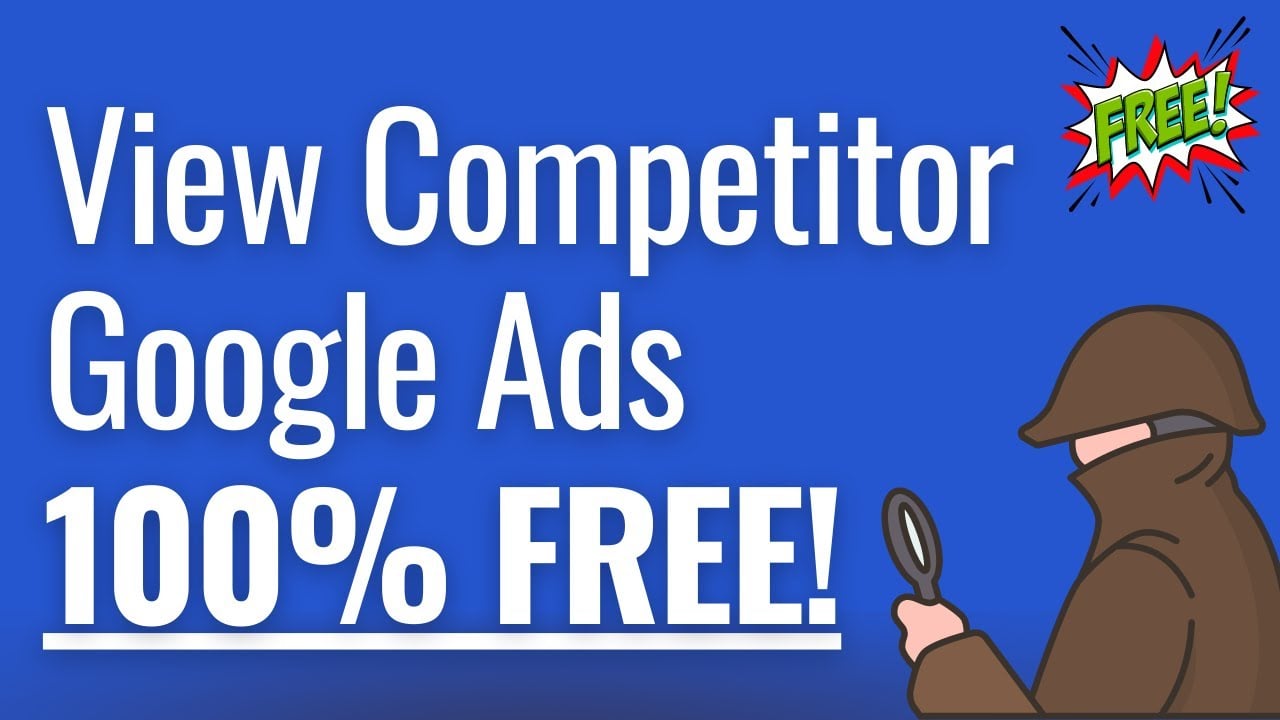- google adwords competitor analysis
- Accessing Competitor Data Limitations By Google
- Industry-Specific Competitor Data Over Individual Spying
- Overview Of Performance And Impression Share With Auction Insights Report
- Budget Adjustments And Cost-Per-Click Impacted By Competitors’ Changes
- Evaluating Budget’s Impact On Impression Share With Competitive Metrics
- Losing Impression Share As Indicator Of Competition, Not Always Need For Top Search Position
- Making Inferences About Competitors’ Behavior Using Industry Trends And Data
- Tools For Google Adwords Competitor Analysis
In the fast-paced world of digital marketing, staying one step ahead of the competition is crucial. And when it comes to Google AdWords campaigns, understanding your competitors can be the key to unlocking success.
But how do you navigate the ever-changing landscape of online advertising? Enter: competitoranalysis.
By diving into the world of Google AdWords competitor analysis, you’ll gain a deep understanding of industry trends, uncover hidden opportunities, and make data-driven decisions that will maximize your ad performance and minimize costs. So, whether you’re a seasoned marketer or just starting out, buckle up and prepare to dive into the world of GoogleAdWordscompetitor analysis.
| Item | Details |
|---|---|
| Topic | Google AdWords Competitor Analysis: Uncover Insights and Dominate |
| Category | Ads |
| Key takeaway | In the fast-paced world of digital marketing, staying one step ahead of the competition is crucial. |
| Last updated | December 28, 2025 |
adwords-competitor-analysis">google adwords competitor analysis
Competitor analysis is an important aspect of running Google AdWords campaigns. It allows advertisers to gain insights into their industry-specific competitors, rather than focusing on individual competitors.
Although accessing competitor data can be challenging due to limitations imposed by Google, there are tools and reports available to help advertisers evaluate the performance and impression share of their competitors. By analyzing changes in competitors’ budgets and identifying new competitors, advertisers can make necessary adjustments to their own budgets and costs-per-click.
Understanding the impact of budget on impression share through competitive metrics is vital. Additionally, losing impression share can indicate increased competition even if the top position in search rankings is not a priority.
Advertisers can make inferences about competitors’ behavior by analyzing industry trends and data. Several tools, such as Google Ads Keyword Planner and third-party tools like iSpionage and AdGooroo, can aid in competitor analysis.
Google Merchant Center provides additional reports and features like the Price Competitiveness report and Best Sellers feature for comparing product prices and identifying top-performing products. Popular tools for Google AdWords competitor analysis include Google Ads Auction Insights, Google Trends, Semrush’s PPC Toolkit, Ahrefs’ Site Explorer, and Spyfu’s PPC Research.
Ultimately, focusing on industry trends is crucial for long-term success in paid search.
Enhanced readability and refreshed statistics.
Key Points:
- Competitor analysis is important for running Google AdWords campaigns.
- Tools and reports are available to help evaluate the performance and impression share of competitors.
- Analyzing changes in competitors’ budgets and identifying new competitors helps make necessary adjustments to budgets and costs-per-click.
- Understanding the impact of budget on impression share is vital.
- Analyzing industry trends and data can provide insights into competitors’ behavior.
- Google Merchant Center provides additional reports and features for comparing product prices and identifying top-performing products.
Sources
https://www.goinflow.com/blog/google-ads-competitor-research/
https://www.spyfu.com/
https://mackiestdon.com/analyze-competitors-google-ads/
https://www.trustradius.com/products/google-ads/competitors
Check this out:
💡 Pro Tips:
1. Look for changes in competitors’ ad copy: Analyze the ad copy of your competitors to understand their messaging strategy and see if they are making any changes. This information can help you adjust your own ad copy to stay competitive.
2. Monitor landing page experience: While competitor analysis is important, don’t forget to focus on your own landing page experience. Make sure your landing pages are optimized for conversions and provide a seamless user experience to give yourself an edge over competitors.
3. Analyze competitor’s display network placements: In addition to analyzing your competitors’ search ads, take a look at where they are displaying their ads on the Google Display Network. This can give you insights on potential advertising opportunities and targeting strategies for reaching your target audience.
4. Consider geolocation targeting: If your business operates in specific regions or cities, analyze how your competitors are targeting those areas. Adjust your geolocation targeting and ad budget accordingly to effectively compete in those locations.
5. Monitor competitor’s social media advertising: Google AdWords is not the only platform for advertising. Keep an eye on your competitors’ social media advertising strategies across platforms like Facebook, Instagram, and Twitter. This can give you insights into their broader digital marketing efforts and help you stay competitive across multiple channels.
Accessing Competitor Data Limitations By Google
In Google AdWords campaigns, competitor analysis plays a crucial role in maximizing the effectiveness of your advertising efforts. However, obtaining competitor data can be challenging due to limitations imposed by Google.
While Google Ads does not provide direct access to specific competitor information, there are alternative methods to gain valuable insights.
To navigate these limitations, it is important to focus on industry-specific competitor data rather than obsessing over individual competitors. Analyzing the industry as a whole allows you to identify trends, patterns, and potential opportunities that may arise from competitor behavior.
Industry-Specific Competitor Data Over Individual Spying
Instead of engaging in traditional spying techniques, such as monitoring individual competitors’ strategies, it is more effective to analyze the overall landscape of your industry. By understanding the actions and trends of your industry counterparts, you can better position your own Google AdWords campaigns for success.
One way to obtain industry-specific competitor data is through the use of the Auction Insights Report in Google Ads. This report provides an overview of how your ad performance compares to your competitors, including impression share and other key metrics.
It allows you to identify who you are competing against and assess their level of visibility in the market.
Overview Of Performance And Impression Share With Auction Insights Report
The Auction Insights Report in Google Ads provides a comprehensive overview of how your ads are performing in comparison to your competitors. It allows you to gauge your impression share, the percentage of times your ad appears in relation to the total available impressions.
This information helps you understand your market position and identify areas for improvement.
Furthermore, the Auction Insights Report enables you to analyze your competitors’ impression share and performance, gaining insights into their strategies and potential areas of vulnerability. By understanding how you stack up against your competition, you can make informed decisions about budget allocation and campaign optimization.
Budget Adjustments And Cost-Per-Click Impacted By Competitors’ Changes
Competitors’ actions can have a significant impact on your Google AdWords campaigns, particularly in terms of budget adjustments and cost-per-click (CPC). Changes in competitors’ budgets can affect the auction dynamics, leading to fluctuations in CPC.
It is crucial to stay vigilant and monitor any shifts in your industry that could impact your advertising costs.
Analyzing competitor behavior also helps you identify new competitors entering the market. Understanding their strategies and budgets can inform your own budget adjustments and bidding strategies, allowing you to remain competitive while keeping costs in check.
Evaluating Budget’s Impact On Impression Share With Competitive Metrics
To evaluate the impact of your budget on impression share, it is essential to analyze competitive metrics. By comparing your ad position, impression share, and click-through rates to those of your competitors, you can assess the effectiveness of your budget allocation.
Additionally, monitoring changes in impression share over time can reveal shifts in market dynamics and competitive landscape. Losing impression share may indicate increased competition or changes in consumer behavior, necessitating adjustments in your AdWords strategy to maintain visibility.
Losing Impression Share As Indicator Of Competition, Not Always Need For Top Search Position
While obtaining the top position in search rankings is often considered the ultimate goal, it is not always necessary for success in Google AdWords campaigns. Losing impression share can actually serve as a valuable indicator of intensified competition.
By assessing your impression share against that of your competitors, you can identify areas where your advertising strategy may need improvement.
Instead of solely focusing on securing the top position, it is crucial to create a comprehensive strategy that considers the overall market landscape. By monitoring competitors and industry trends, you can make data-driven decisions and allocate resources effectively to maximize campaign performance.
Making Inferences About Competitors’ Behavior Using Industry Trends And Data
In the absence of specific competitor data, it is possible to make inferences about competitors’ behavior by analyzing industry trends and data. By examining keyword search volumes, bid trends, and shifts in consumer preferences, you can gain insights into your competitors’ strategies and adjust your own campaigns accordingly.
Using tools such as Google Ads Keyword Planner, you can identify profitable keywords and ad groups that can generate incremental revenue and help you achieve your key performance indicators (KPIs). Third-party tools like iSpionage, AdGooroo, Google Trends, Semrush’s PPC Toolkit, Ahrefs’ Site Explorer, and Spyfu’s PPC Research provide valuable competitor insights and market trends, allowing you to stay ahead in your AdWords campaigns.
Tools For Google Adwords Competitor Analysis
To perform a thorough competitor analysis in Google AdWords, various tools are available to assist you. These tools offer invaluable insights and help you dominate your industry in paid search.
Here are some notable tools for Google AdWords competitor analysis:
Google Ads Auction Insights: Provides essential competitor performance and impression share data within Google Ads platform. – iSpionage: Offers competitor data, including keywords, ads, and landing pages, to help you identify gaps and opportunities.
AdGooroo: Provides comprehensive competitor analysis, including keywords, ad copy, and budget allocation. – Google Trends: Enables you to identify and analyze search trends and patterns in your industry, aiding in predicting competitors’ behavior.
Semrush’s PPC Toolkit: Offers competitor analysis, keyword research, and data on CPC distribution. – Ahrefs’ Site Explorer: Provides insights into competitors’ backlinks, organic keywords, and search traffic.
Spyfu’s PPC Research: Helps uncover competitors’ ad spend, keywords, and ad copy.
By utilizing these tools and focusing on industry trends, you can gain a competitive edge and achieve long-term success in Google AdWords campaigns.
In conclusion, competitor analysis is of utmost importance in Google AdWords campaigns. While accessing specific competitor data may be challenging, industry-specific competitor data and insights can be obtained through alternative means.
By analyzing trends, leveraging tools, and monitoring market dynamics, you can make informed decisions, optimize your campaigns, and dominate your industry in paid search.
Advertising Platform for Marketers • Programmatic Advertising • Performance Marketing Tips











